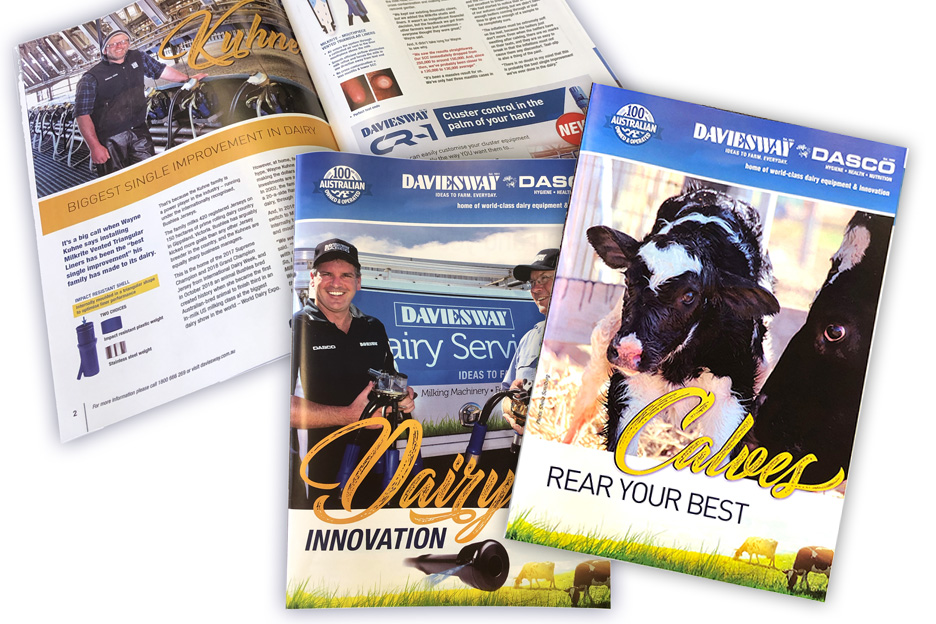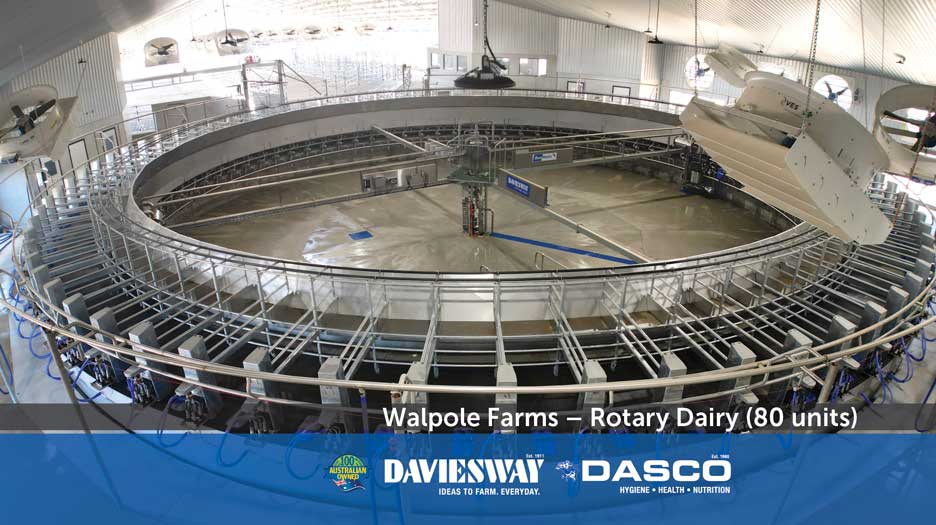
DOING IT FOR THE FAMILY
When four of Mark and Kate Walpole’s six children expressed an interest in dairying, it led their parents to a quantum leap.
Mark and Kate decided to make room for them on the family farm … and by “make room”, they mean they really made room.
The family is now more than halfway through building a multi-million dollar free-stall facility to house and milk 4000 cows, in four 1000-cow free-stall barns, at Yielima, 16km from Nathalia.
 A drone image of the early phase of construction. The dairy facility is at the front left, with two free- stall barns behind it. The effluent handling system is behind them. To the right of the dairy is the water holding dam.
A drone image of the early phase of construction. The dairy facility is at the front left, with two free- stall barns behind it. The effluent handling system is behind them. To the right of the dairy is the water holding dam.
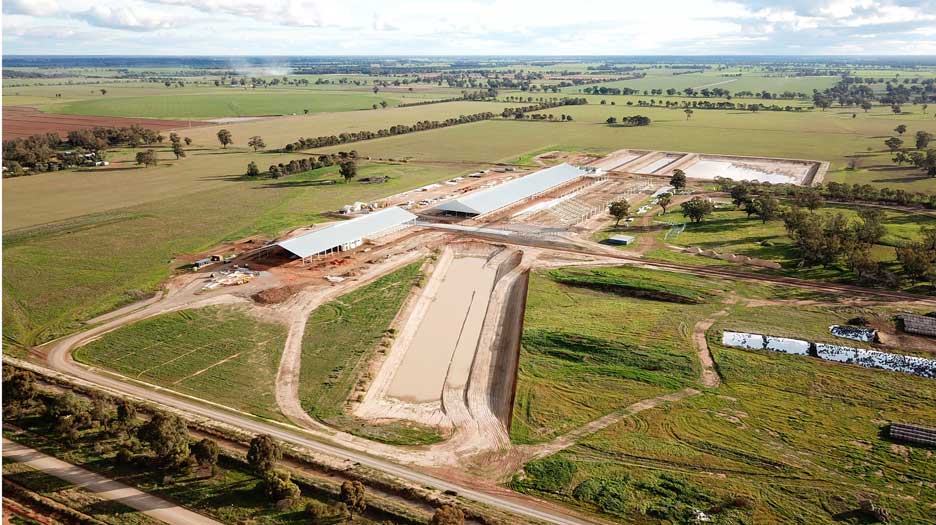 With the roofs on the sheds, the project is starting to take shape with the dairy and water storage dam in the foreground, and the two free-stall barns behind.
With the roofs on the sheds, the project is starting to take shape with the dairy and water storage dam in the foreground, and the two free-stall barns behind.
The 80-stall basement parlour rotary dairy, and two of the four barns, were completed within 14 months. And with this, the family’s footprint is well and truly embedded in the region, following its courageous decision to back the dairy industry in northern Victoria.
The Walpoles are projecting to produce 19 million litres in the next 12 months (off the first 2000 cows), and everyone involved in the construction at Westin Run has been deeply moved by the family’s commitment to this formidable 25-hectare blueprint. The operation has 30 employees on a roster basis, and plan to be milking 4000 cows within five years.
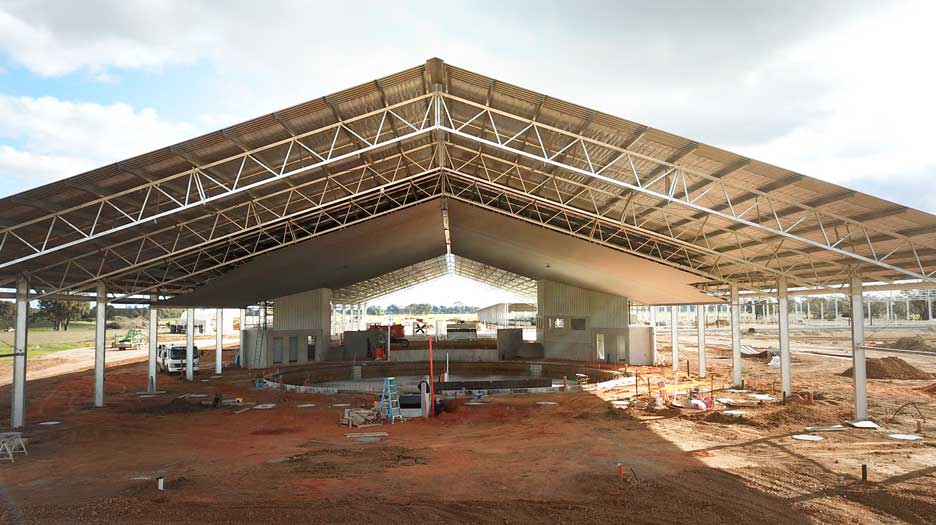 The first view inside the dairy complex, which gives an insight to the scale. The centre floor of the 80-unit rotary has been poured. The shed will end up lined in the front area, and have fans installed to control temperature and humidity.
The first view inside the dairy complex, which gives an insight to the scale. The centre floor of the 80-unit rotary has been poured. The shed will end up lined in the front area, and have fans installed to control temperature and humidity.
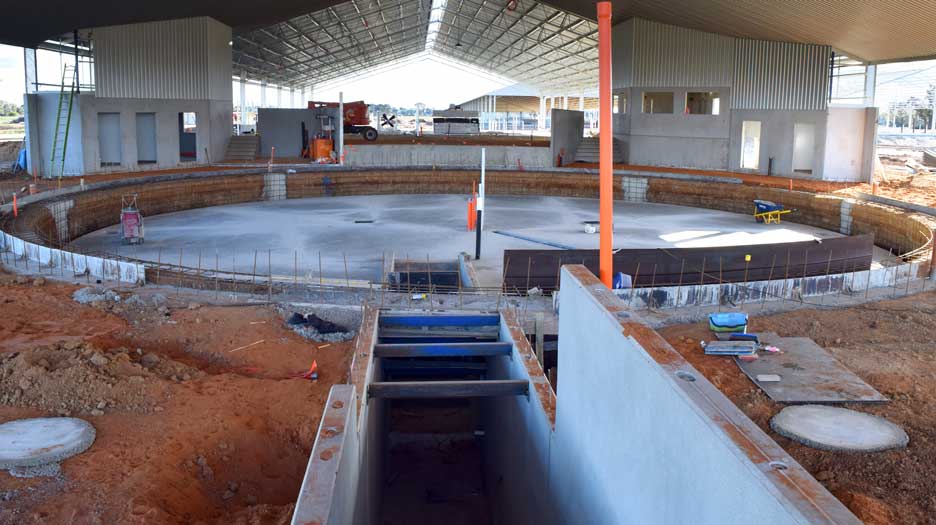 The walls of the sunken centre rotary pictured being prepared for the concrete. The platform bridge, entry, and exit areas are in the background. The underpass was installed using pre-formed slabs. The majority of centre electrical and plumbing ducts are in place at this stage.
The walls of the sunken centre rotary pictured being prepared for the concrete. The platform bridge, entry, and exit areas are in the background. The underpass was installed using pre-formed slabs. The majority of centre electrical and plumbing ducts are in place at this stage.
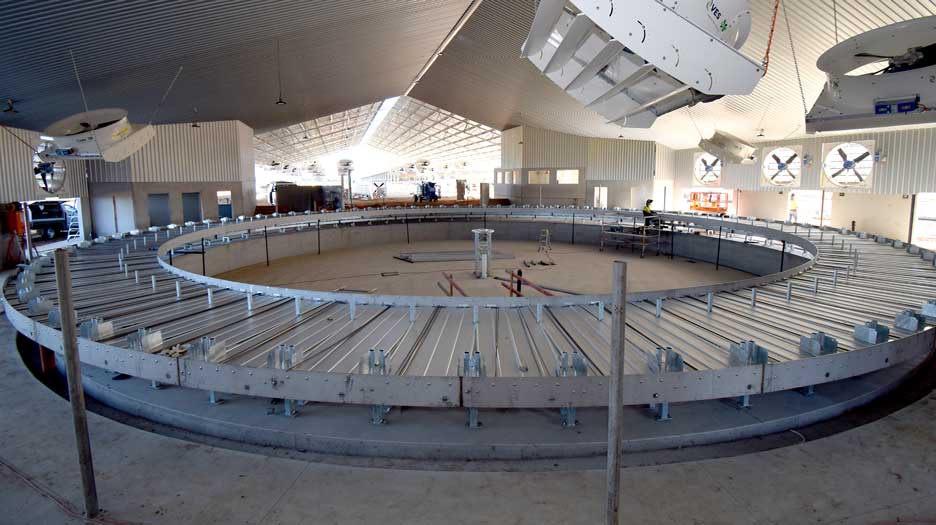 With all the concrete in the dairy area poured, construction can continue. The footings for the rotary platform have been installed, along with the track and the base of the deck. The dairy area roof is now lined for insulation and cleanliness. The fans have been installed to create airflow above the cows during milking, in addition to the fans through the facility – with units also mounted in the walls.
With all the concrete in the dairy area poured, construction can continue. The footings for the rotary platform have been installed, along with the track and the base of the deck. The dairy area roof is now lined for insulation and cleanliness. The fans have been installed to create airflow above the cows during milking, in addition to the fans through the facility – with units also mounted in the walls.
This is one of just two dairies of this size in Australia – and both have been built by Daviesway DASCO.
Daviesway DASCO’s Nico Polato has project managed the Walpoles’ dairy build, and pitched in with his support on the barn builds. He puts the family’s decision – which had to weather COVID-19 challenges and delays – into perspective.
“This is a commercial-scale development, operated by the one family,” Nico says.
“It is truly an extreme example of what can be done with careful planning, and by following that plan.
“The Walpole family have enormous faith in the future, they are smart, they are fully committed, and they have an amazing dynamic together. They are also really good with the cows. It all comes down to a good management team.”
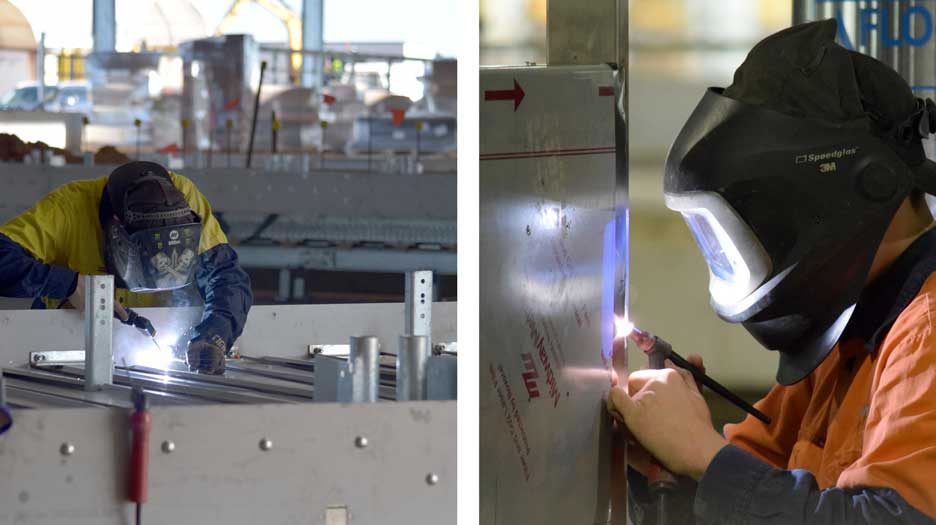 There is a huge amount of welding in these facilities, with mild steel being welded for the platform (left), and stainless-steel components for the milking equipment (right) being shown here.
There is a huge amount of welding in these facilities, with mild steel being welded for the platform (left), and stainless-steel components for the milking equipment (right) being shown here.
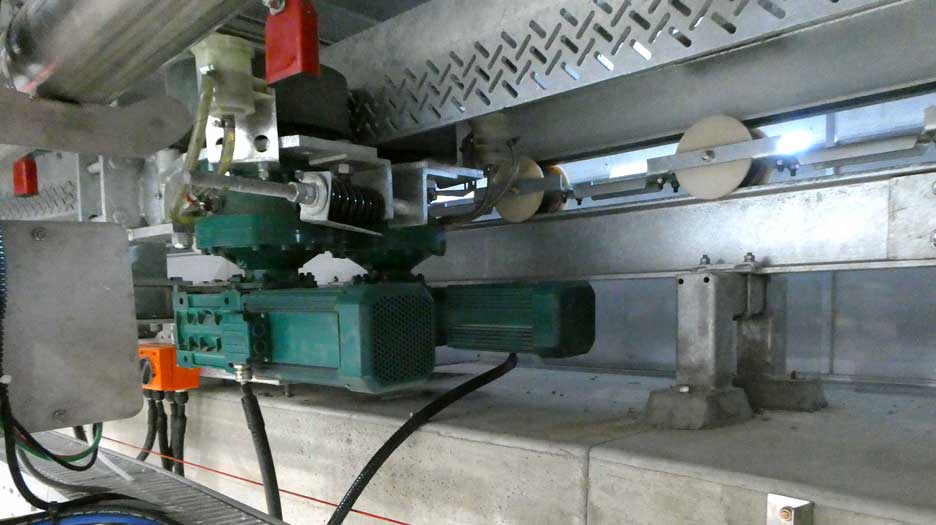 The 80-unit platform has three drive assemblies with variable speed control. The track sits on nylon rollers tied into a chain to guarantee even loading.
The 80-unit platform has three drive assemblies with variable speed control. The track sits on nylon rollers tied into a chain to guarantee even loading.
FACILITY COVERS 25HA
The finished facility will cover 25 hectares (62 acres) of an additional 607ha (1500 acres) property they bought four years ago. It’s an imposing sight to turn off the main road and take in the magnitude of what one family has put in place.
They also lease 405ha (1000 acres) opposite Westin Run, and have retained the home farm, which is 260ha (12km from the new hub). That property, which includes a 50-stand rotary, also has a feed pad that has been re-purposed for dry cows and heifers. It will be used for calving, drying off, rearing calves, and transition or sick cows.
FAMILY COMMITMENT
It is early days for the family, and there is no doubt a lot for them to get their heads around, but they are navigating the new systems and routines together.
Mark and Kate’s offspring who have involvement on the farm are: Zena, 28, who works part time on the rosters (she and husband Andrew have two children); Beau, 26, who has a light-metal fabrication trade at Yarroweyah Engineering (he and wife Sheridan have three children); Corey, 23, who is the cowman; and Matyka, 22, who works with the calves. Neither Kyara, 25, nor Tazma, 21, work on-farm.
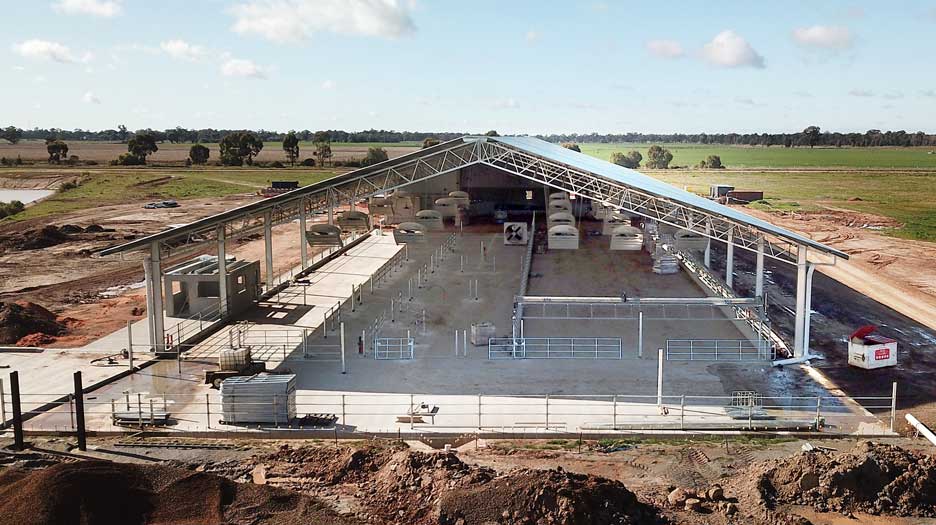 This drone image shows the undercover cattle handling area of the dairy facility. On the right is the main cattle yard with an automated backing gate system. The left includes a drafting area, in addition to other cattle handling equipment. The automated fans ensure a pleasant environment for operators and animals.
This drone image shows the undercover cattle handling area of the dairy facility. On the right is the main cattle yard with an automated backing gate system. The left includes a drafting area, in addition to other cattle handling equipment. The automated fans ensure a pleasant environment for operators and animals.
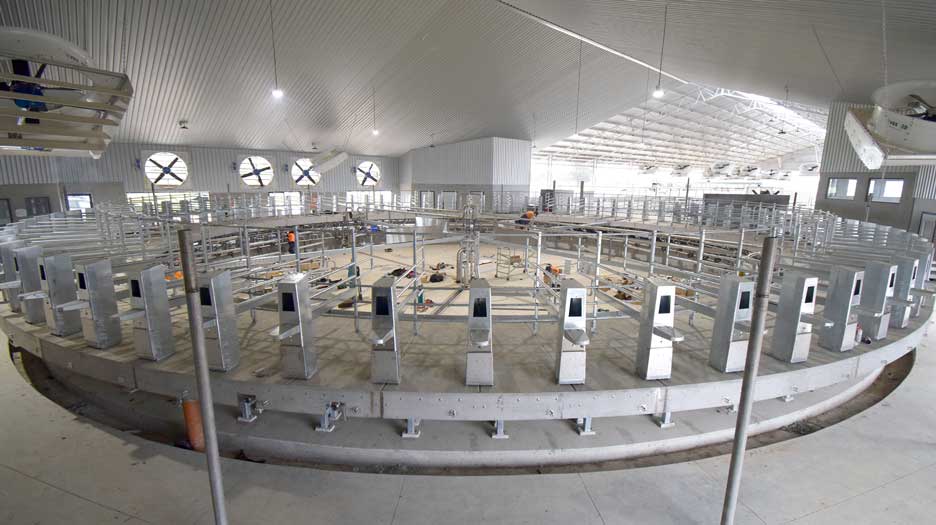 The rotary milking facility is taking shape with the concrete poured and the cabinet divider bails installed. The cabinet will house the cluster remover controls, rams, and the wash jetters. The centre gland and all main milking machine lines have been installed at this point.
The rotary milking facility is taking shape with the concrete poured and the cabinet divider bails installed. The cabinet will house the cluster remover controls, rams, and the wash jetters. The centre gland and all main milking machine lines have been installed at this point.
Mark Walpole, 52, says his advice for anyone considering this kind of commitment remains the same.
“If you want to do it, just do it,” he says. “But definitely do a lot of homework. From when we first looked at doing it to when we started building, the cost had increased by 50-60% because of COVID. If we had put it off – and people did suggest that we do that – we reckoned it would have been just as expensive in two or three-years’ time.
“In all honesty, in another five years’ time we’d still be saying it was too much. It’s always more expensive further down the track. That’s why I always say if you want to do it, just do it now.”
COW COMFORT AND FAMILY
The Walpoles’ motivation starts and ends with family.
Mark says growing up, his parents Lloyd and Kerin expanded enough for both he and his brother Adam to be involved.
“That thinking sort of just followed on from there. You hear a lot of people say the kids want to come home to the farm, but they only have room for one. I didn’t want to say that to our kids.
“But to continue to work together, we needed enough room so we weren’t all hitting heads, and everyone had room to grow and to have something they could be in charge of. In saying that, what we’ve done here also excited me a bit.”
The Walpoles know that they are farming in a demanding summer climate, and the 230-metre-long barns include one fan every 12 metres (43 fans per barn), triggered automatically by temperature and humidity sensors. The barn roofs rise from 5m (eave height) to 11m at the apex. The cows are bedded in deep, clean sand, which is sourced locally. The sand was a late change from dried manure, which needed a design pivot later in the game, with adding a sand-recovery lane and extra wash valves.
Mark says he didn’t hesitate to make the significant capital investment in northern Victoria – even though the region can be dogged by water challenges.
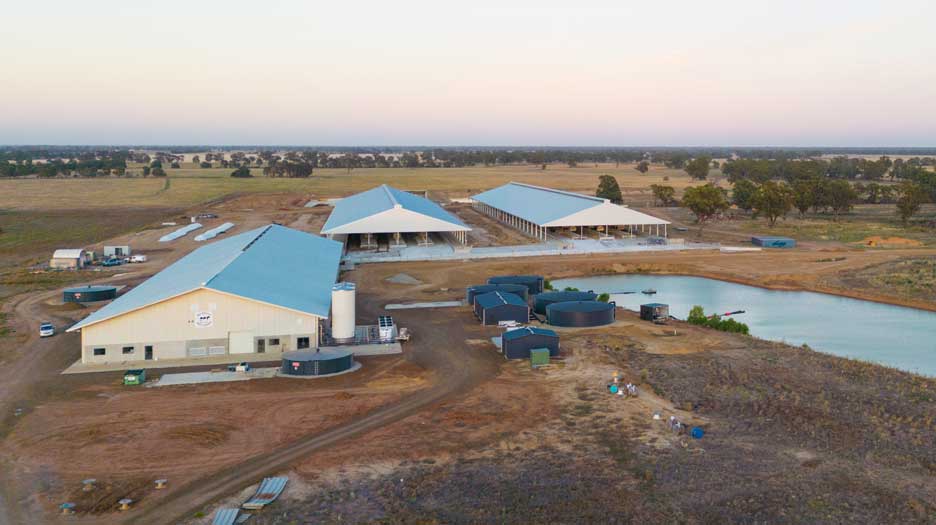 With the project nearing completion, the scale can now fully be appreciated. The main dairy facility holding the 80-unit rotary, in addition to the cattle handling facilities and administration offices dominates the foreground. The two 40,000 litre milk silos sit on the right of the shed with the glycol chiller units right next door. The ancillary sheds to the right of the dairy house the facility’s electrical boards and water pumps.
With the project nearing completion, the scale can now fully be appreciated. The main dairy facility holding the 80-unit rotary, in addition to the cattle handling facilities and administration offices dominates the foreground. The two 40,000 litre milk silos sit on the right of the shed with the glycol chiller units right next door. The ancillary sheds to the right of the dairy house the facility’s electrical boards and water pumps.
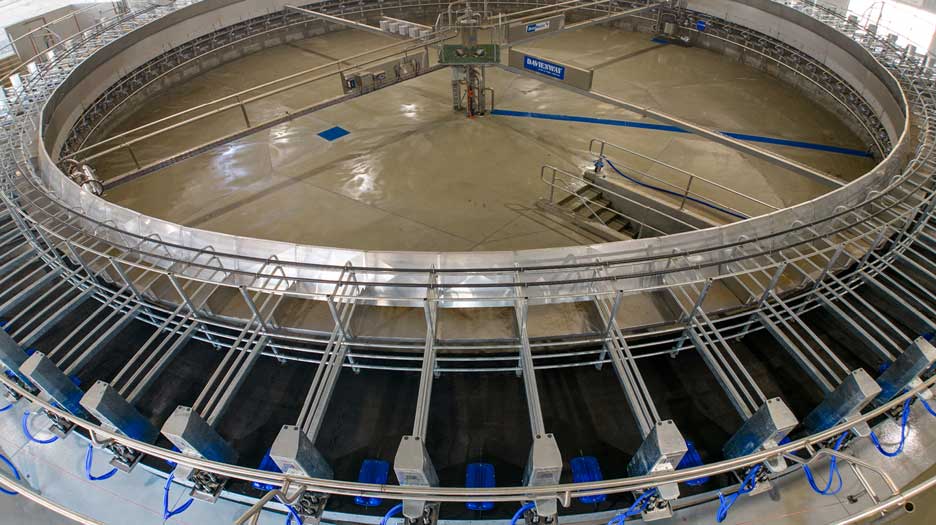 Heavy duty rubber mats were installed on the platform for cow comfort. The sub way entrance to the centre of the dairy allows operators or maintenance staff to access the heartbeat of the dairy if required without interrupting milking.
Heavy duty rubber mats were installed on the platform for cow comfort. The sub way entrance to the centre of the dairy allows operators or maintenance staff to access the heartbeat of the dairy if required without interrupting milking.
“I reckon this is not a bad area as far as milking cows goes. Access to feed here is pretty easy, access to transport is pretty easy, and marketing your milk from here is pretty easy.
“We are on the north side of Melbourne, and it’s easier for the milk to go north. Booths Transport is at Strathmerton and they are carting milk to South Australia and Queensland.
“This is just more manageable as far as looking after the cow comfort and feed, and to be able to milk a lot of cows in a controlled environment, when they are protected from the elements.”
GLOBAL RESEARCH
Mark admits the idea had been rolling around in his head for 22 years after visiting Moxey Farms in NSW.
Their preparation for this build also included multiple international trips, linking into the greatest minds globally on the best way to comfortably house cows. In particular, they honed in on Jake Martin (Dairy Design Engineer), the owner of JGMIII, Inc., who operates out of Florida in the USA. Mark also travelled with Scott Rathbone, of CRC Agrisolutions, who is based at Congupna in northern Victoria.
The combination of international advice, and their own experience teamed with local specialist knowledge at Daviesway DASCO, gave them the confidence to move forward.
BOUMATIC BUILT FOR THE JOB
The BouMatic equipment from the USA has a global reputation for providing heavy-duty milking equipment to milk large numbers of cows every day. Daviesway DASCO is BouMatic’s Australian distributor, and the local service agent is ND Services, just minutes away at Numurkah – who also work closely with Daviesway DASCO. The platform was built by Hargreaves at Yarroweyah.
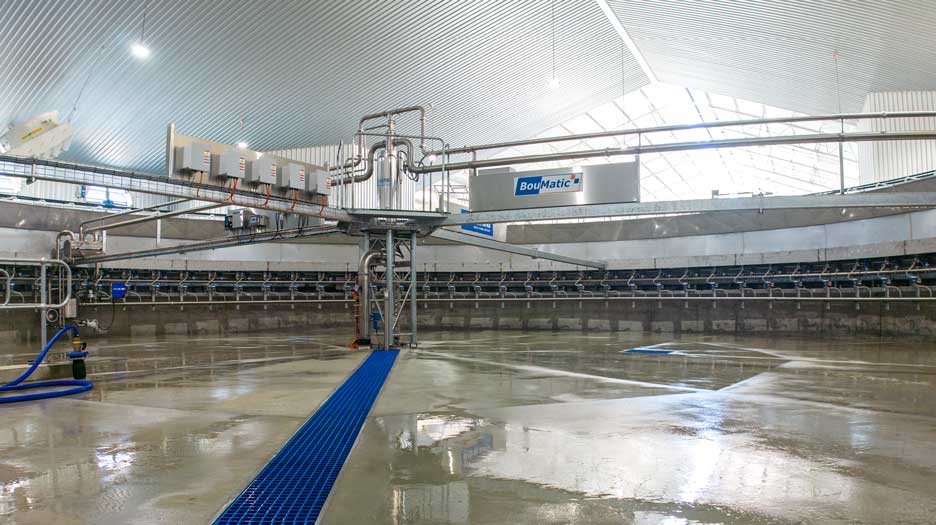 The centre gland assembly carries vacuum, milk delivery, compressed air and electrical connections to the rotary. Equipment panels carry transformers and control equipment.
The centre gland assembly carries vacuum, milk delivery, compressed air and electrical connections to the rotary. Equipment panels carry transformers and control equipment.
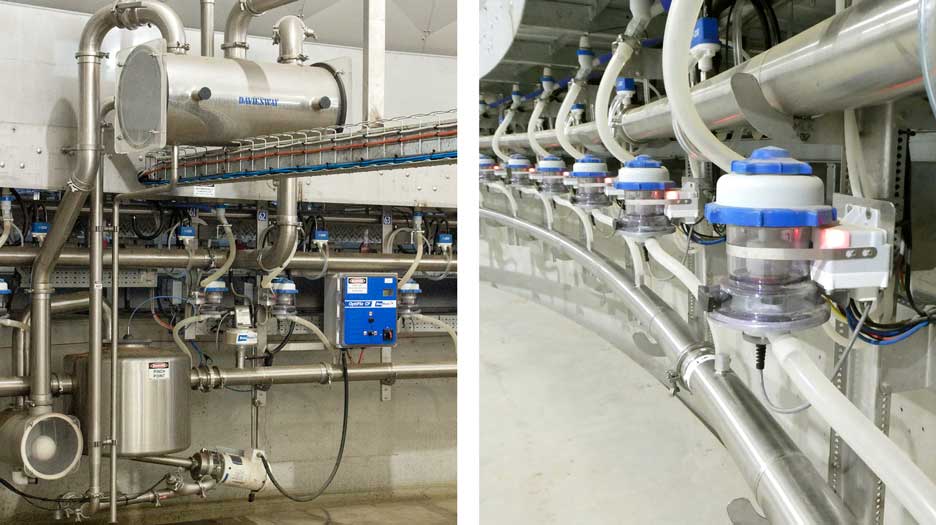 There are two receiver sets on the 80-unit rotary. Each has pneumatically controlled milk line and drain valves, a 3hp milk pump with variable speed control, an air purge system to remove milk and wash residue from the delivery line – and isolation valves so lines or equipment can be easily tested or repaired.
There are two receiver sets on the 80-unit rotary. Each has pneumatically controlled milk line and drain valves, a 3hp milk pump with variable speed control, an air purge system to remove milk and wash residue from the delivery line – and isolation valves so lines or equipment can be easily tested or repaired.
The specification includes milk metering, a pulsator per cluster and pneumatically operated shut-off valves.
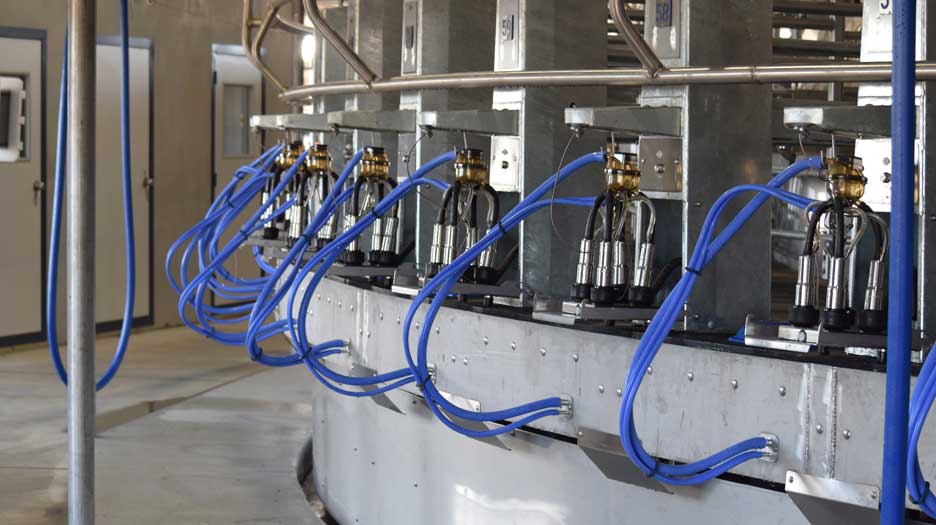 The MAX cluster paired with the Turbo Magnum vented liner provide a lightweight cluster designed to comfortably milk quickly, completely, and cleanly. Port nipple plates mean the silicone dropper is sitting in the right place every time, and the deflector plate helps to guide the cluster over the under edge of the platform when it is lifted for the operator to attach to the cow.
The MAX cluster paired with the Turbo Magnum vented liner provide a lightweight cluster designed to comfortably milk quickly, completely, and cleanly. Port nipple plates mean the silicone dropper is sitting in the right place every time, and the deflector plate helps to guide the cluster over the under edge of the platform when it is lifted for the operator to attach to the cow.
This dairy will be working for 22 hours a day when everything is in place – stopping twice for two washes. It is backed up by two vacuum pumps, two compressors, and can be serviced while it’s moving with the cows on the platform. The seven-stall exit is over the bridge, allowing for unimpeded cow flow. Low-profile stall cabinets are designed to be inviting, and they also make exiting easier. They include an integrated system console to house SmartDairy automation components.
The dairy includes a basement and underpass, which allows for uninterrupted operator access at herd testing or for maintenance operations. All milking and automation equipment is housed in the basement.
Like the barns, the dairy and the yard include large, automated fans that are driven by the heat and humidity. They reduce the fly loads and make the working environment as comfortable for the cows as it is for staff.
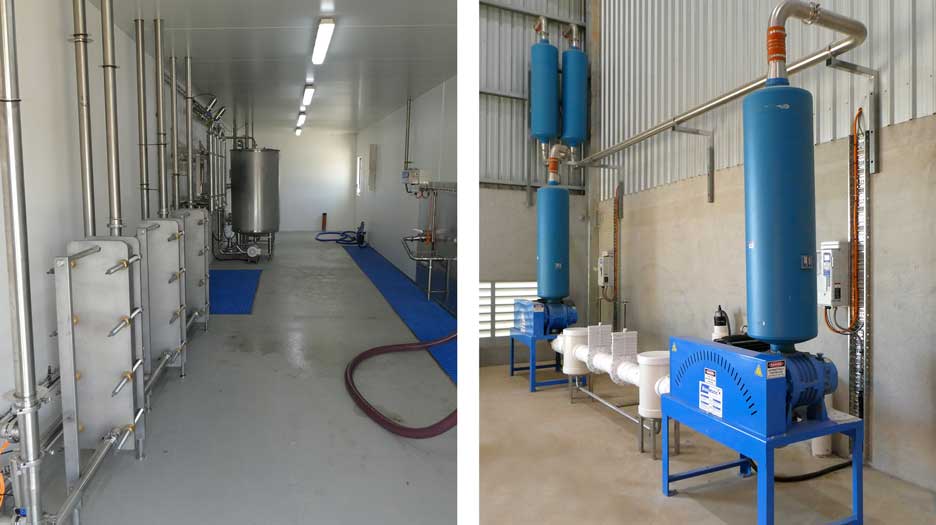 On the left is the milk receival room. The two on-platform milk pumps deliver the milk to the holding tank. A separate pump with variable speed drive is then used to pump the milk through the multiple filters and coolers before entering the vat chilled. The multiple filters operate in banks, that can be isolated with a flick of switch so filter sleeves can easily be changed during milking.
On the left is the milk receival room. The two on-platform milk pumps deliver the milk to the holding tank. A separate pump with variable speed drive is then used to pump the milk through the multiple filters and coolers before entering the vat chilled. The multiple filters operate in banks, that can be isolated with a flick of switch so filter sleeves can easily be changed during milking.
On the right, twin blower vacuum pumps are also controlled through separate variable speed drives. They can be easily isolated for maintenance. The large exhaust system ensures a quiet environment both inside and outside of the dairy operating area..
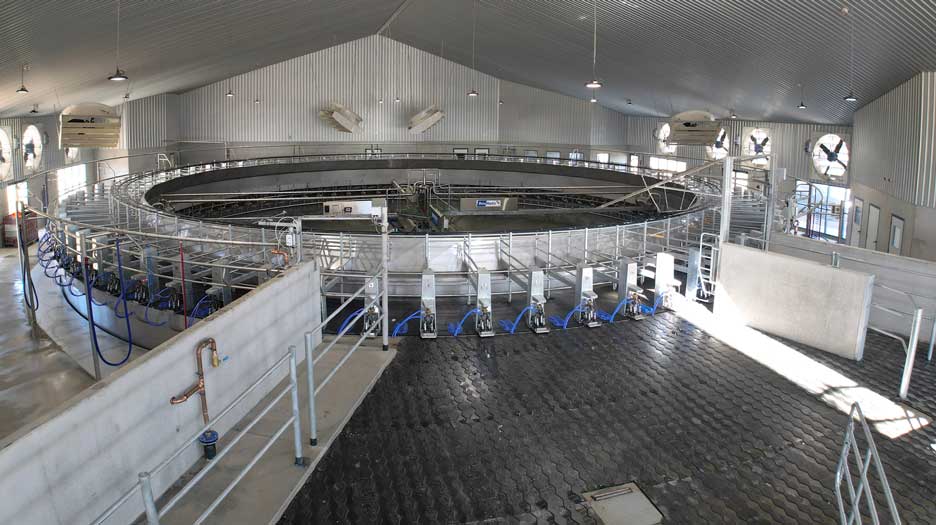 The six-cow exit area allows a generous area for cows to back off and turn without blocking the area. The fully rubbered area reduces hoof fatigue and increases cow safety and comfort. The low-profile bails allow the cows to turn earlier – because their head is easily above the bails – which also helps with comfort and therefore productivity.
The six-cow exit area allows a generous area for cows to back off and turn without blocking the area. The fully rubbered area reduces hoof fatigue and increases cow safety and comfort. The low-profile bails allow the cows to turn earlier – because their head is easily above the bails – which also helps with comfort and therefore productivity.
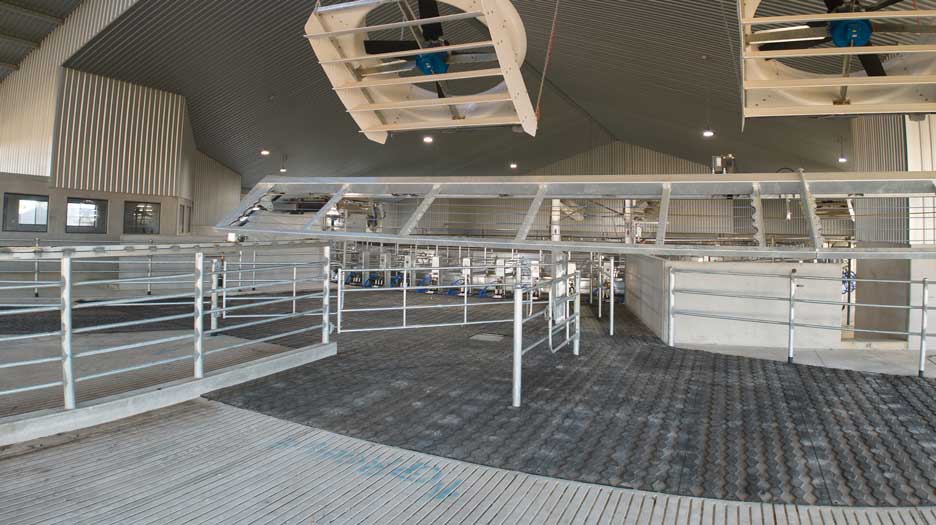 The heavy duty up-and-over backing gate is designed to bring one herd in with a second following. At herd change time, the gate lifts and goes back over the next herd – achieving an almost seamless process between herds. Rubber has also been used in this area where cows can push while entering the platform.
The heavy duty up-and-over backing gate is designed to bring one herd in with a second following. At herd change time, the gate lifts and goes back over the next herd – achieving an almost seamless process between herds. Rubber has also been used in this area where cows can push while entering the platform.
The family’s plan has always been to pay for the two barns and the dairy at the front end of the project, and to use the revenue from there to finish the final two barns. Having used sexed semen, they have the cows to push on and build the final two sheds now. however, that final decision is yet to be made.
Mark says, “Because we’ve spent a lot of money building a dairy and effluent system that can milk 4000 cows – and it’s currently milking 2000 – it makes sense to fully utilise that, and make the best of your capital investment by getting to your 4000 cows as quickly as possible.
“But, it’s a big step, so we need to make sure that our management can keep up with that growth.”
PROJECT MANAGER PIVOTAL
Mark says their decision to engage Nico as a project manager turned out to be imperative.
“I wasn’t sure if I needed Nico at first. Some people say you need a project manager, some people say you don’t. But there is no way I would have been able to do it myself.
“The further we’ve got into it, that became clear with everything else that was going on just running the farm every day. Yesterday we had two trucks delivering grain, a fertiliser truck here, two other trucks carting manure, an excavator digging a drain and we are milking 1400 cows and feeding calves.
“Especially when we were building the electrics and plumbing stuff, and making sure everything is right.
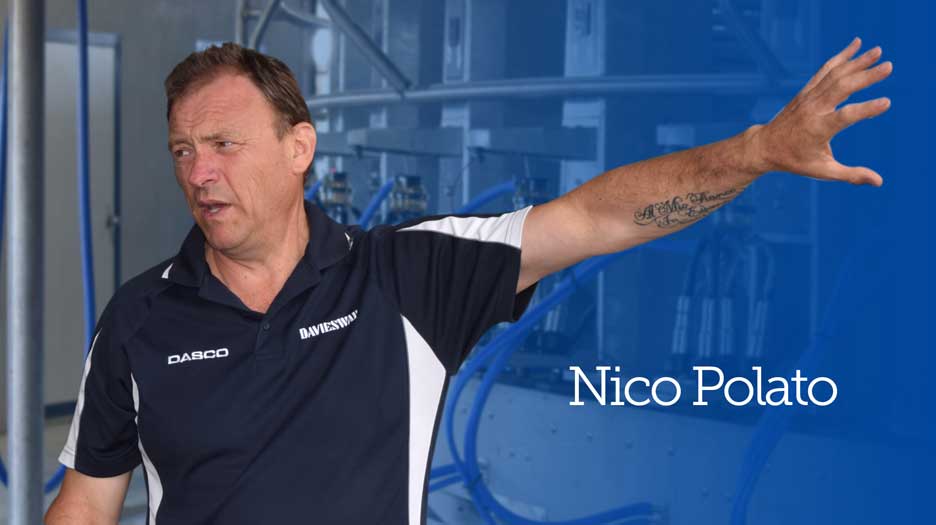 Daviesway special dairy project manager.
Daviesway special dairy project manager.
“Everyone is asking me, ‘What do you want to do with this, and what do you want to do about that?’, and to be honest, I just rang Nico.
“The amount of time he’s dedicated to bits and pieces of this project and how much he understands has shown me that it would take me twice as long to get the information, and it’s easy to doubt yourself with that technical knowledge.”
The other contractors also appreciate Nico’s ability to see in his mind’s eye how things would play out.
Local plumber Sam Rankin, of Rankin Plumbing, says even for experienced contractors this was a behemoth mission.
“All the trades need to come together on a job like this,” Sam says. “To get all the electrical, plumbing and hydraulics working correctly.
“We’d have meetings, and it can get pretty confusing – even for us. It was great how Nico can just picture everything in his head, and how it’s all going to go together. To have someone who knows working alongside us on the project has been gold.”
WATER AND THE EARLY MILKINGS
Water was always going to be an important subject in northern Victoria. A 40ML fresh-water pond has been built. Everything is flood washed, and recycled water is used to flood-wash the dairy and barns. The recycling water can then be pumped out for irrigation, thus refreshing the flood wash.
There are three centre pivots irrigators (1 x 8 span, 2 x 6 span) that can put 20mls on 125ha in a day. They can also use bore and channel water at 70ML a day. Barring zero allocations for water at local government level, the property is self-sufficient.
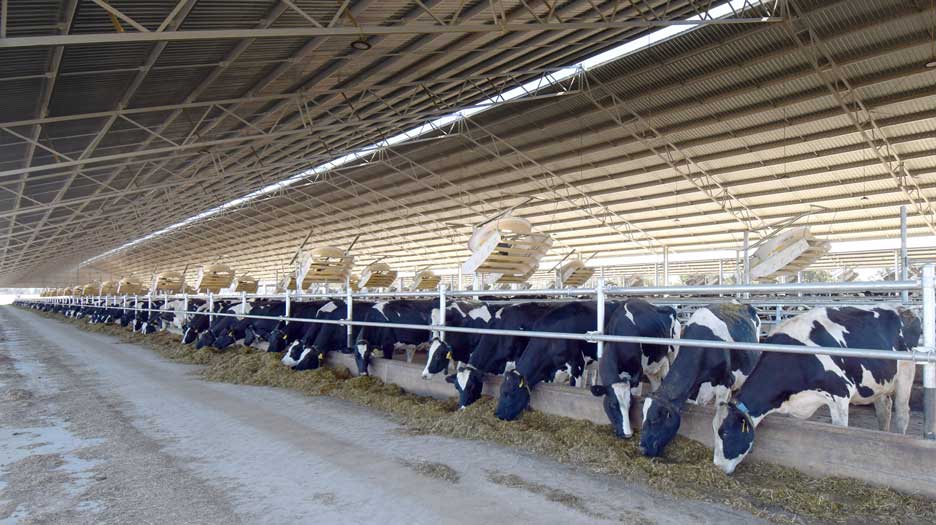 The feed alley is refreshed several times during the day, depending on how the herd is being managed. Fans are controlled through a variable-speed drive according to temperature, humidity and wind speed. Water troughs are also placed through the barn environment.
The feed alley is refreshed several times during the day, depending on how the herd is being managed. Fans are controlled through a variable-speed drive according to temperature, humidity and wind speed. Water troughs are also placed through the barn environment.
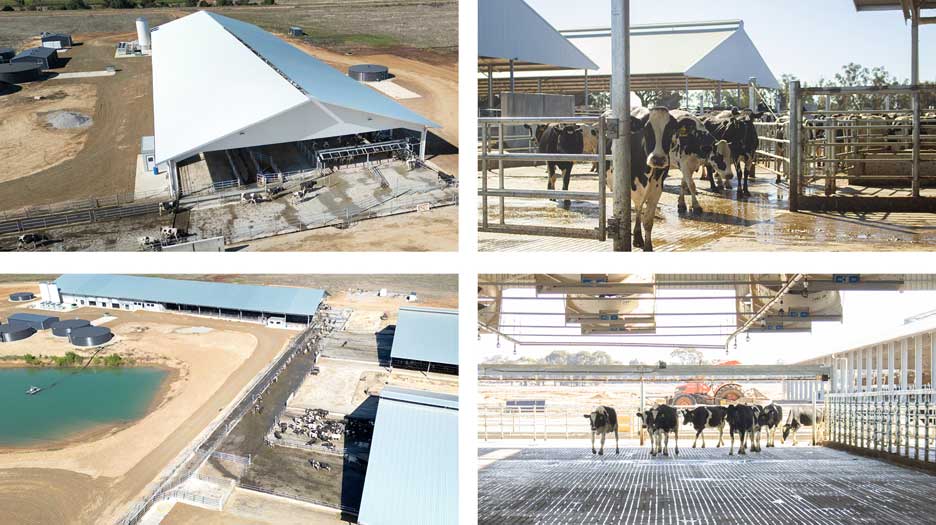 Some shots showing the cow flow from the barns to the dairy.
Some shots showing the cow flow from the barns to the dairy.
(Top and bottom left) show the cows moving along the barn-cross lane, and into the dairy yard.
(Top and bottom right) shows a standing perspective of the cows coming into the dairy yard from the barn-cross lane. The concrete is all grooved for a non-slip surface.
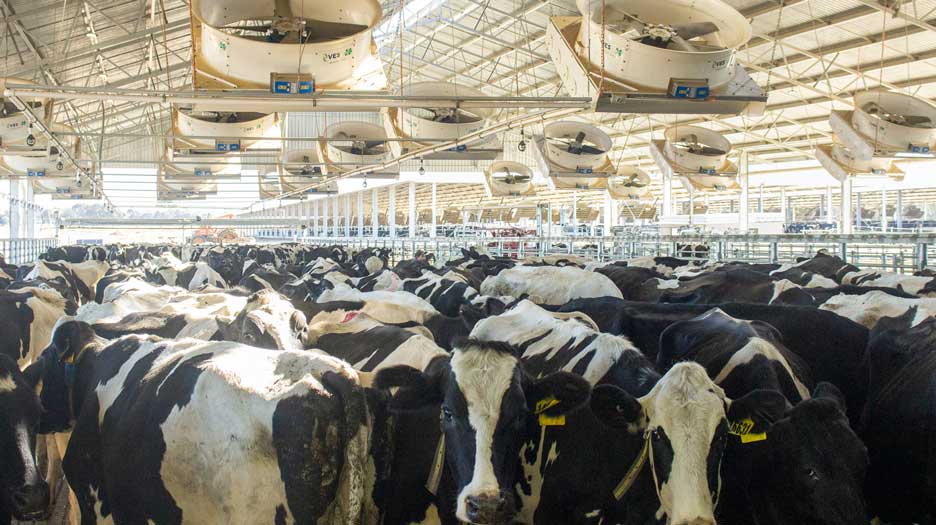 Cows in the main yard are ready to be milked. The backing gate is about to be dropped. The high number of fans help to reduce heat and fly load, while the cows are so close together. Cow comfort is covered with this design.
Cows in the main yard are ready to be milked. The backing gate is about to be dropped. The high number of fans help to reduce heat and fly load, while the cows are so close together. Cow comfort is covered with this design.
The first cows came through the dairy on February 15, 2023. This was after a brutally cold spring coupled with widespread flooding in the region. Westin Run wasn’t flooded, but fodder quality was impacted by 30% in quantity and quality. The home farm was bogged down with too many cows waiting to switch farms, and in the end, the family made the decision to harvest a fair bit of grain instead of putting it into silage as they had planned, because they couldn’t get their machines on the paddocks.
The new property has a herringbone dairy, so the first 390 cows were settled in the barns and milked through that, before being walked to the new rotary.
Mark says, “The first milking went surprisingly well. The cows had been here a fortnight, then we started bringing 20 more from the home farm every day, then we brought 450.
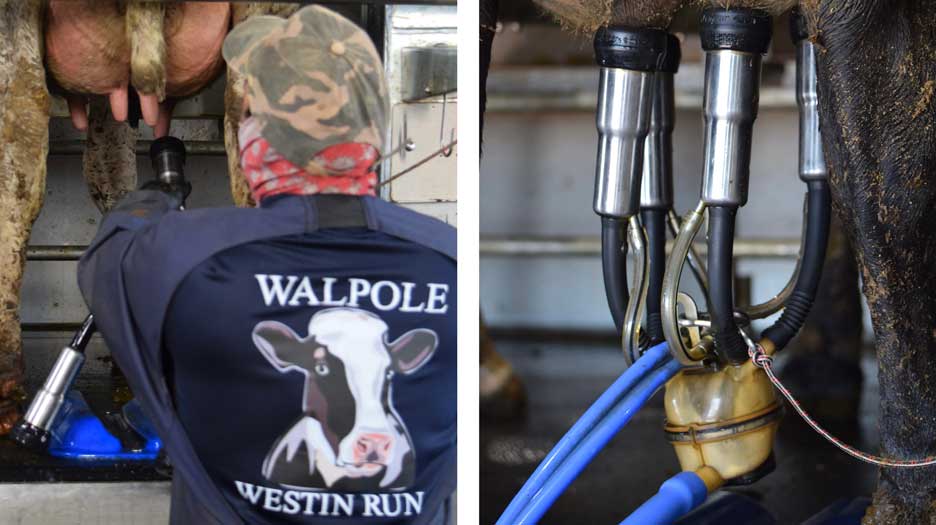 The operators at Westin Run adapted quickly to the new equipment. The lightweight high-flow claws look after cows and operators.
The operators at Westin Run adapted quickly to the new equipment. The lightweight high-flow claws look after cows and operators.
“Those later-arriving cows were less settled. We had milked them at home in the morning, put them on a truck, and then put them into the barns where everything was new.
“We then pushed them up into a new dairy that day and it was too much. For their first couple of milkings, they were reasonably stirry, but they settled into the barn beds quicker than I expected.”
The production improvements in the new dairy have been hard to gauge, given the season, feed quality and transition. Before the shift, the herd was producing around 1.9-2kg of milk solids (MS) a cow per day. Mark is hoping for a 2-2.3kg MS average on the new farm, but notes they are pulling cows back from a 1.6kg MS spring average.
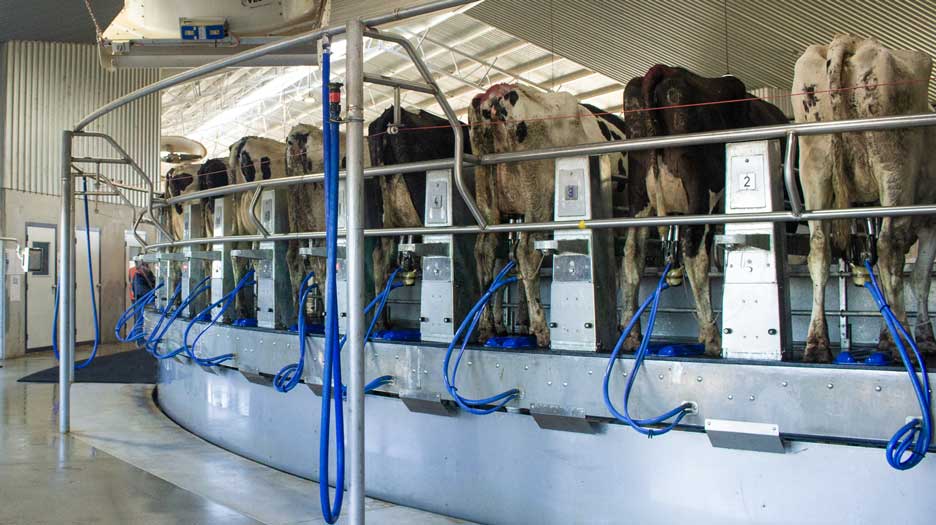 Wash down hoses are placed at regular intervals around the rotary to help with cleanliness. Locators mounted on the rubber mats ensure cows stand to allow easy cluster attachment and complete coverage with automatic teat spraying.
Wash down hoses are placed at regular intervals around the rotary to help with cleanliness. Locators mounted on the rubber mats ensure cows stand to allow easy cluster attachment and complete coverage with automatic teat spraying.
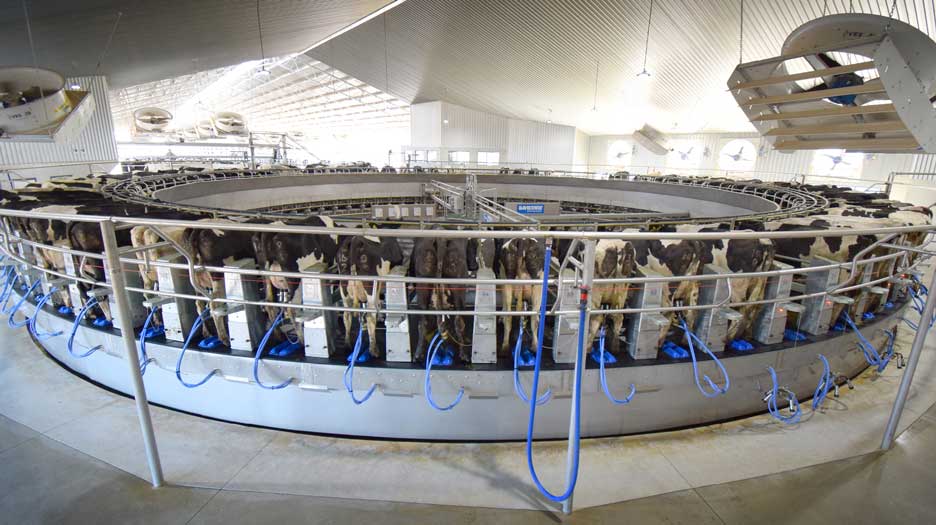 With the milking in full swing, the automatic cluster removal can be seen coming off the cow, and dropping automatically under the platform so it’s ready to go under the bridge.
With the milking in full swing, the automatic cluster removal can be seen coming off the cow, and dropping automatically under the platform so it’s ready to go under the bridge.
NEW DAIRY FOR FULL-LACTATION COWS
The new dairy will cater for the cows that are in full production.
“We will continue to calve on the home farm. The fresh cows and/or sick cows will be milked there too, and that milk will be fed to the calves at home. We will also take the cows back there to dry off. If we are going to milk 4000 cows in this dairy, we can’t be drying off or treating hospital cows here.”
Mark says he was looking forward to the additional leverage they potentially had as a large, single-site milk harvester. That came to fruition when they began supplying Fonterra on 1 July.
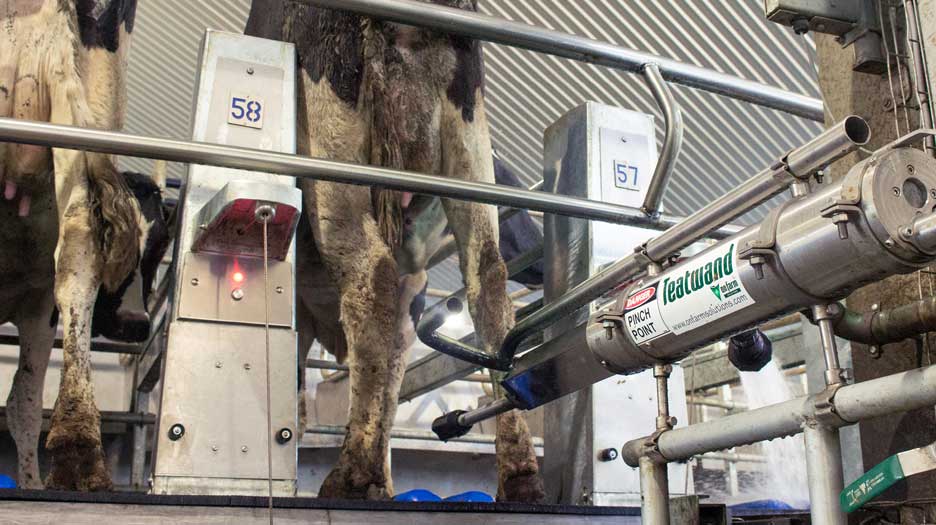 Cows’ teats are sprayed automatically at the exit before they return to the barn.
Cows’ teats are sprayed automatically at the exit before they return to the barn.
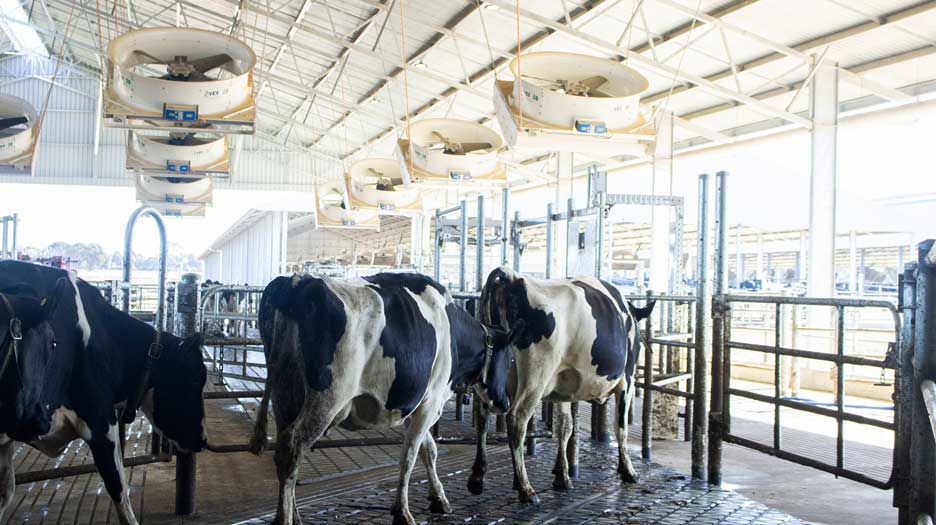 Once cows leave the platform, they are walking on rubber until they leave the main dairy area. The draft gate and cattle handling area also feature matting, which is placed strategically for cow and operator comfort. Again, fans complete a better environment for cows and operators.
Once cows leave the platform, they are walking on rubber until they leave the main dairy area. The draft gate and cattle handling area also feature matting, which is placed strategically for cow and operator comfort. Again, fans complete a better environment for cows and operators.
NO REGRETS
As far as regrets go, unsurprisingly Mark doesn’t have much time for those. He’s a humble and hard-working dairy farmer who not only dreamed big, he made it happen.
“We’re happy, although I will admit that I have spent a fair bit of time wondering why we got on the bus at times during this build,” he smiles.
“People do ask me why we’d bother spending this much money at this point of our career. The truth is partly because I’ve always wanted to do it, and it’s exciting, and partly because the kids are also interested.
“We’re a family working together. We’re pretty honest in saying that it’s not always perfect, but we all get along well, and this operation is big enough that we’re not on top of one another, and we’re not physically working together all the time. That was always our plan.
“This gives our entire family a future in this industry.”
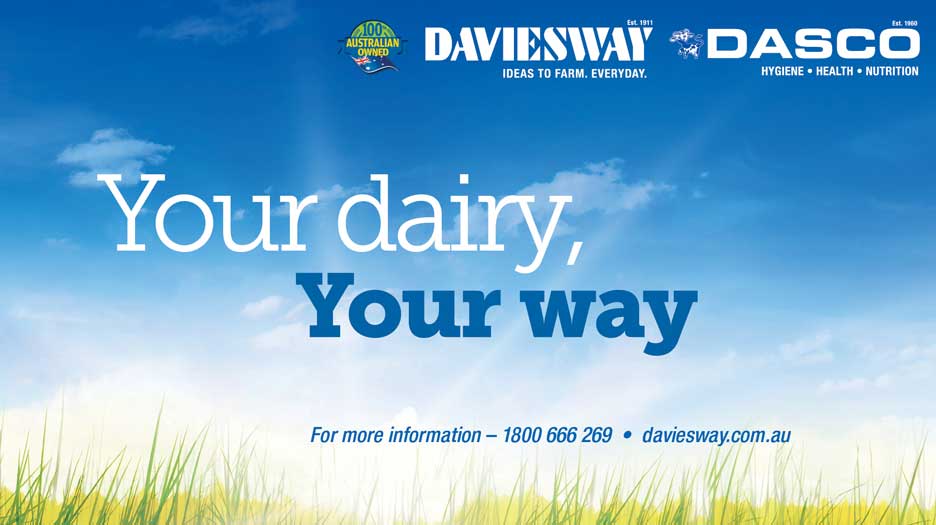
NICO POLATO
DAVIESWAY SPECIAL DAIRY PROJECT MANAGER
Mobile: 0428 517 363
Email: nico.polato@daviesway.com.au
FREE CALL DAVIESWAY – 1800 600 269
See more Daviesway Dairy project information below
![]() Daviesway – Build Your Dairy Your Way
Daviesway – Build Your Dairy Your Way
![]() Dairy needs updating – Renovate or build?
Dairy needs updating – Renovate or build?
.

